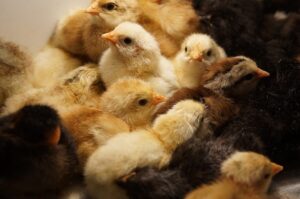Ah, the joy of hatching and incubating eggs—a mix of science, nature, and pure magic! Whether you’re a homesteader cultivating your backyard flock or a poultry enthusiast aiming to perfect your first hatch, this guide will walk you through every step of the process. By the time you’re done reading, you’ll feel like a pro ready to hatch your own fluffballs of happiness.
Understanding Fertile Eggs
First, let’s crack open (pun intended) the basics of fertile eggs.
How Does Fertilization Happen?
Ever wonder where chicks come from? Fertilization occurs when a rooster mates with a hen, delivering sperm to fertilize her eggs. Sounds simple, right? The magic is all in nature’s design. Did you know that hens can store sperm for up to two weeks, allowing for multiple fertile eggs from a single encounter? Chickens are efficient little creatures.
Spotting Fertile vs. Infertile Eggs
Here’s where it gets tricky. Candling—shining a light through the egg—is your secret tool. Fertile eggs often reveal a subtle bullseye-shaped spot in the yolk, while infertile eggs look like, well, normal yolks. Don’t worry; practice makes perfect with this step!
Proper Rooster-to-Hen Ratios
Too many roosters, and you’ve got stressed-out hens. Too few, and your fertility rates drop. Aim for one rooster per 8-10 hens. Your hens will thank you for the balance.
Collecting and Storing Fertile Eggs
Handle these little treasures with care. Store them pointy-end down, keep the temperature between 50-60°F, and turn them once a day to keep yolks from settling. But don’t wait too long—eggs are best incubated within 7 days for optimal hatch rates.
Pre-Incubation Preparation
Before the magic begins, clear some space and prep the right tools.
Selecting the Right Incubator
There are two main types of incubators you’ll encounter:
- Still-Air Incubators: Budget-friendly but require extra attention to maintain even heat.
- Forced-Air Incubators: Better air circulation and easier to control.
And don’t forget the turning mechanism. Automatic turners save you time (and sanity), while manual turning is more hands-on but gets the job done.
Incubator Setup
Choose a quiet, draft-free spot with a stable power source (because nothing kills the mood like a power outage mid-hatch). Calibrate your incubator before adding eggs—99.5°F is the sweet spot with 45-50% humidity.
The Incubation Process
The eggs are in, and the countdown begins!
Temperature Requirements
Steady heat is key. Keep your incubator at 99.5-100.5°F. Even small fluctuations can impact your hatch rate. Invest in a good thermometer and keep a backup nearby. No, “eyeballing it” will not work—trust me.
Humidity Control
- Days 1-18: Aim for 45-50% humidity to prevent moisture loss.
- Days 19-21: Bump it to 65-70% for smoother hatching.
Sounds like a lot of numbers, but your water reservoirs do most of the work.
Turning Eggs
Manual turning? Rotate each egg at least three times a day. Automatic turner? Sit back and relax while the machine earns its keep. Proper turning prevents embryos from sticking to the shell and ensures even development.
Ventilation
Eggs are like tiny lungs—they need oxygen. Keep vents open enough for airflow while carefully monitoring humidity. Don’t neglect this step—stale air equals unhappy chicks.
Monitoring Development
Get ready for some egg-spectacular detective work.
Candling Schedule
- Day 7: Look for spiderweb-like blood vessels and a developing embryo.
- Day 14: More defined forms—your chick is growing!
- Day 18: Double-check development before locking down. No skipping this step, okay?
Identifying Problems
Not every egg makes it. Blood rings, stuck embryos, or air cell issues can happen. While it’s tough, identify problem eggs early to avoid affecting the batch.
Blood rings can be identified by the appearance of red lines around the egg. Stuck embryos can be detected by not seeing any movement or development within the egg. Air cell issues can be seen if there is a significant difference in weight between eggs, indicating improper air flow.
Stuck embryos can be carefully removed from the egg to prevent contamination. Blood rings and air cell issues may require adjusting humidity levels or turning methods.
Lockdown Period (Days 18-21)
Lockdown means no more turning or opening the incubator—minimal disturbance ensures maximum hatching success. Increase humidity to 65-70% and position eggs correctly with their large end up. The wait can be nerve-wracking, but trust the process.
Hatching Process
The long-awaited moment is here!
Signs of Imminent Hatching
Look for pipping—a small crack or bump in the shell. This means your chick is on its way!
Monitoring the Hatch
Maintain stable temperature and humidity. Need to assist? Proceed with caution—interventions should be rare and only if absolutely necessary.
Post-Pip Care
Resist the urge to help too much. Chicks need time to work their way out; it’s part of their development. Rule of thumb? Only intervene if a chick has been stuck for 24+ hours post-pip.
Post-Hatch Care
Congratulations! You’re a chick parent.
- Leave chicks in the incubator until they dry (they’ll look fluffier and more adorable).
- Transfer to a brooder setup with a heat lamp and clean bedding.
- Focus on hydration and a chick starter feed to give them a healthy, happy start.
Troubleshooting Common Problems
Not every hatch goes perfectly. Here are common issues and how to address them:
- Temperature swings: Stabilize your incubator ASAP.
- Humidity issues: Adjust water reservoirs. Dry eggs need more, wet eggs need less.
- Turning failures: Manually check and rotate if needed.
- Late/early hatches: Double-check your setup and logs to pinpoint issues.
Record Keeping
Hatching is a science, after all. Log fertility rates, candling results, humidity levels, and hatch rates. Over time, you’ll spot patterns and improve with each batch.
Special Considerations
Every species has its quirks—duck eggs need more humidity, and quail eggs hatch faster. Genetics, seasons, and even breeding stock can impact success rates, so keep an eye on the big picture.
Equipment Checklist
- A reliable incubator
- Thermometer and hygrometer (because accuracy matters)
- Candling light
- Backup power supply
- Sanitation supplies for post-hatch cleanup
Wrapping It Up
Hatching eggs is a rewarding experience that takes patience, preparation, and attention to detail. With this guide, you’re now equipped to take on the challenge and welcome brand-new life into the world.
Need help selecting the perfect incubator or troubleshooting your setup? Drop your questions in the comments or reach out to the poultry-loving community.
Here’s to successful hatching and happy chicks! 🐣
For more on chicken care:
Navigating Chicken Zoning Laws
Chicken Respiratory Infections: Herbal Options
Fermenting Herbs for Chicken Gut Health
Chicken Foraging and Free Ranging
Best Chicken Breeds for Egg Laying
Safely Introducing New Hens to Your Flock

